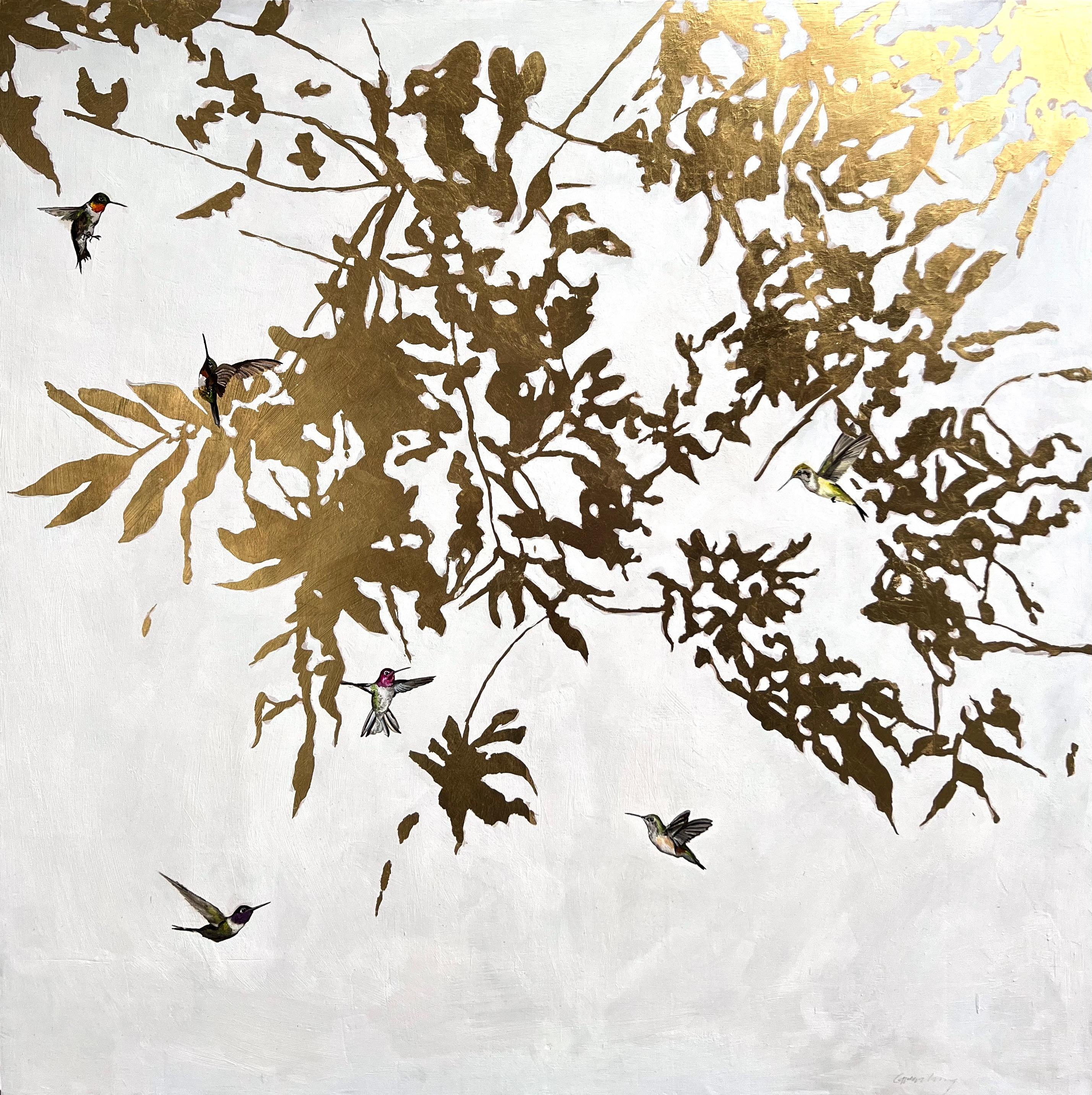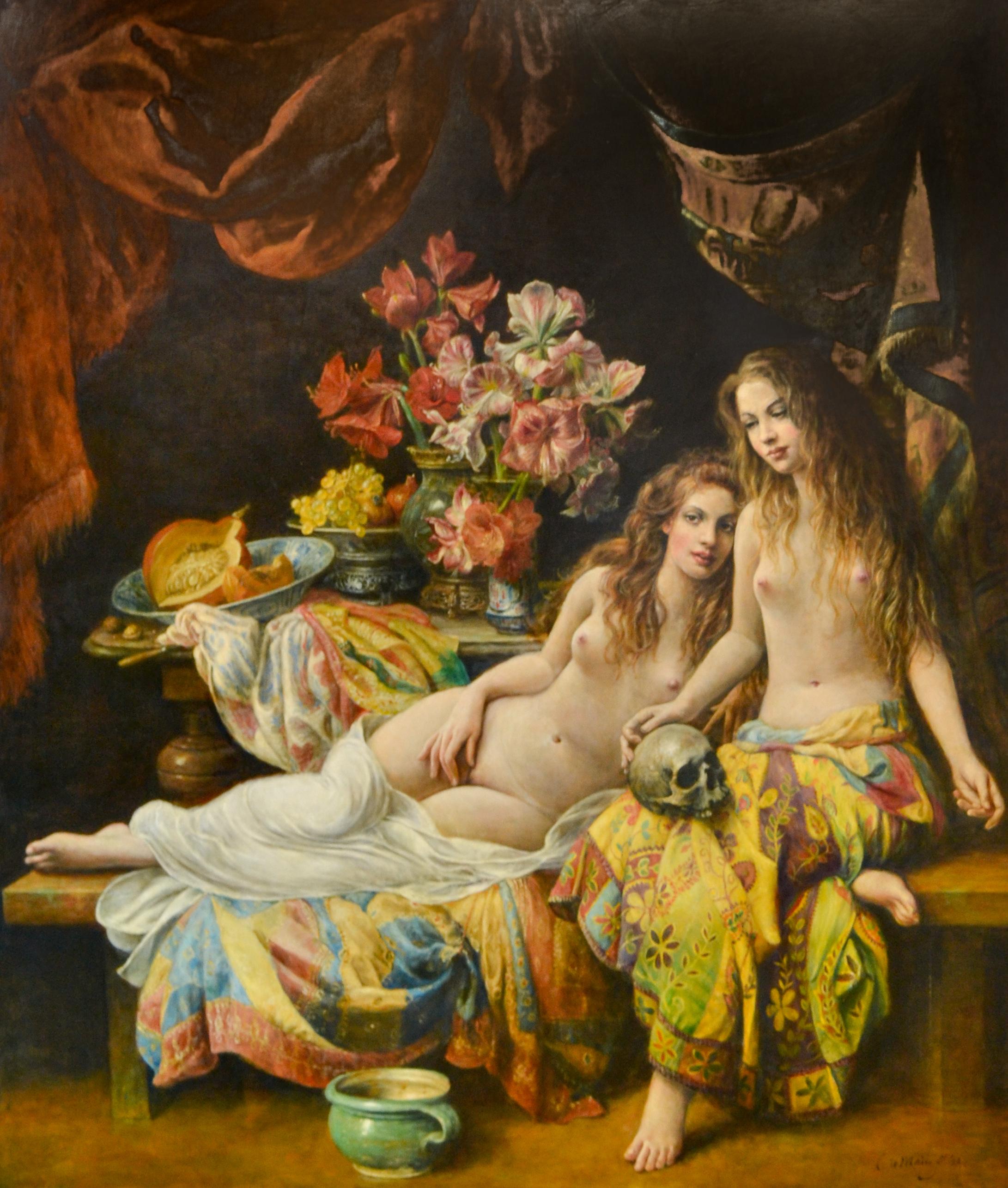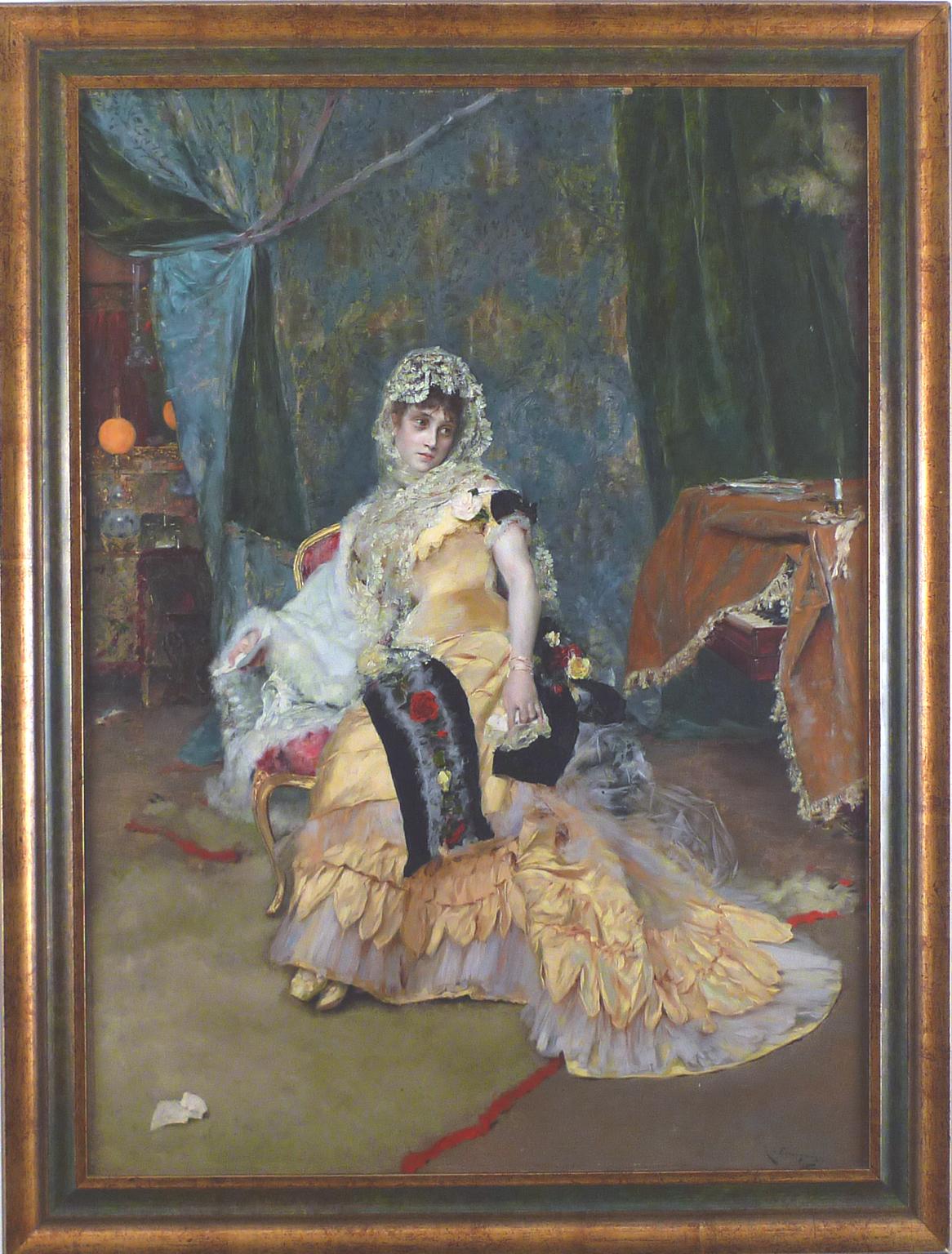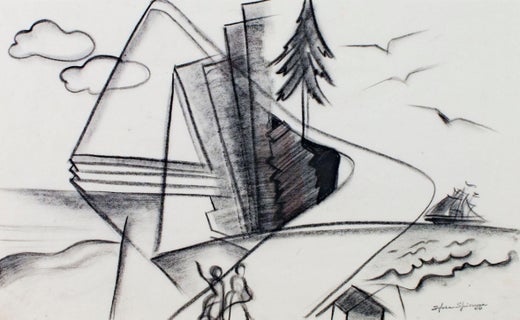Items Similar to "On Wisconsin, " Oil on Panel Portrait by Sylvia Spicuzza
Want more images or videos?
Request additional images or videos from the seller
1 of 10
Sylvia Spicuzza"On Wisconsin, " Oil on Panel Portrait by Sylvia Spicuzzacirca 1950
circa 1950
About the Item
"On Wisconsin" is an original oil painting on panel by Sylvia Spicuzza. The artist signed the piece in the lower left. This painting depicts two figures and other symbols to represent the state of Wisconsin, Sylvia's home state.
24" x 18" art
30 5/8" x 24 5/8" frame
Born in 1908, Sylvia Spicuzza was the daughter of noted painter Francesco Spicuzza. Sylvia devoted herself to teaching art to the students of Lake Bluff Elementary School in Shorewood, WI. During this time Sylvia produced a magnificent body of work that was undiscovered until her death. Sylvia's work is rich, diverse and fascinating collection of drawings, watercolors and prints from the 1920's to the 1990's. Her style ranges from early figurative drawings to regionalism, art deco, lyrical abstractions of every conceivable subject (both real and imagined), as well as figurative paintings that reflect the work of Picasso and Ernest Max in the 1930's and 1940's. Biomorphic and organic, Modernist images are presented with Sylvia Spicuzza's own unique sense of style, humor and fantasy.
- Creator:Sylvia Spicuzza (American)
- Creation Year:circa 1950
- Dimensions:Height: 30.625 in (77.79 cm)Width: 24.625 in (62.55 cm)
- Medium:
- Period:
- Condition:
- Gallery Location:Milwaukee, WI
- Reference Number:
Sylvia Spicuzza
Born in 1908, Sylvia Spicuzza was the daughter of noted painter Francesco Spicuzza. Sylvia devoted herself to teaching art to the students of Lake Bluff Elementary School in Shorewood, WI. During this time Sylvia produced a magnificent body of work that was undiscovered until her death. Sylvia's work is rich, diverse and fascinating collection of drawings, watercolors and prints from the 1920's to the 1990's. Her style ranges from early figurative drawings to regionalism, art deco, lyrical abstractions of every conceivable subject (both real and imagined), as well as figurative paintings that reflect the work of Picasso and Ernest Max in the 1930's and 1940's. Biomorphic and organic, Modernist images are presented with Sylvia Spicuzza's own unique sense of style, humor and fantasy. Exhibitions David Barnett Gallery, Milwaukee, Wisconsin Education Northwestern University, MFA, Illinois
About the Seller
4.9
Platinum Seller
These expertly vetted sellers are 1stDibs' most experienced sellers and are rated highest by our customers.
Established in 1966
1stDibs seller since 2017
391 sales on 1stDibs
Typical response time: 1 hour
- ShippingRetrieving quote...Ships From: Milwaukee, WI
- Return PolicyA return for this item may be initiated within 14 days of delivery.
More From This SellerView All
- "Caterina d'Alexandria (Saint Catherine of Alexandria)" classical religiousBy (After) GiampietrinoLocated in Milwaukee, WI"Caterina d'Alexandria (Saint Catherine of Alexandria)" is an original oil painting on wood panel, likely painted by Italian artist Giampietrino (Giovanni Pietro Rizzoli). The painti...Category
19th Century Old Masters Portrait Paintings
MaterialsOil, Wood Panel
- Native American Nature Village Community Western 1970's Animals Seasons SignedBy Charles DamrowLocated in Milwaukee, WI"Teepee/Indian Village" is an original oil painting on wood panel by Charles Damrow. The artist signed and dated the piece in the lower left. This paint...Category
1970s American Impressionist Landscape Paintings
MaterialsOil, Wood Panel
- "Over Here, " Surreal Acrylic Painting on Canvas Panel by Reginald K. GeeBy Reginald K. GeeLocated in Milwaukee, WI"Over Here" is an original acrylic painting on canvas panel by Reginald K. Gee. The artist initialed the piece on the back. This artwork features an abstracted figure in pink waving ...Category
1990s Contemporary Figurative Paintings
MaterialsAcrylic, Panel, Canvas
- 'Sketching Wisconsin' original oil painting, SignedBy John Steuart CurryLocated in Milwaukee, WIJohn Steuart Curry "Sketching Wisconsin," 1946 oil on canvas 31.13 x 28 inches, canvas 39.75 x 36.75 x 2.5 inches, frame Signed and dated lower right Overall excellent condition Presented in a 24-karat gold leaf hand-carved wood frame John Steuart Curry (1897-1946) was an American regionalist painter active during the Great Depression and into World War II. He was born in Kansas on his family’s farm but went on to study art in Chicago, Paris and New York as young man. In Paris, he was exposed to the work of masters such as Peter Paul Rubens, Eugène Delacroix and Jacques-Louis David. As he matured, his work showed the influence of these masters, especially in his compositional decisions. Like the two other Midwestern regionalist artists that are most often grouped with him, Grant Wood (American, 1891-1942) and Thomas Hart Benton (American, 1889-1975), Curry was interested in representational works containing distinctly American subject matter. This was contrary to the popular art at the time, which was moving closer and closer to abstraction and individual expression. Sketching Wisconsin is an oil painting completed in 1946, the last year of John Steuart Curry’s life, during which time he was the artist-in-residence at the University of Wisconsin in Madison. The painting is significant in Curry’s body of work both as a very revealing self-portrait, and as a landscape that clearly and sensitively depicts the scenery of southern Wisconsin near Madison. It is also a portrait of the artist’s second wife, Kathleen Gould Curry, and is unique in that it contains a ‘picture within a picture,’ a compositional element that many early painting masters used to draw the eye of the viewer. This particular artwork adds a new twist to this theme: Curry’s wife is creating essentially the same painting the viewer is looking at when viewing Sketching Wisconsin. The triangular composition of the figures in the foreground immediately brings focus to a younger Curry, whose head penetrates the horizon line and whose gaze looks out towards the viewer. The eye then moves down to Mrs. Curry, who, seated on a folding stool and with her hand raised to paint the canvas on the easel before her, anchors the triangular composition. The shape is repeated in the legs of the stool and the easel. Behind the two figures, stripes of furrowed fields fall away gently down the hillside to a farmstead and small lake below. Beyond the lake, patches of field and forest rise and fall into the distance, and eventually give way to blue hills. Here, Curry has subverted the traditional artist’s self-portrait by portraying himself as a farmer first and an artist second. He rejects what he sees as an elitist art world of the East Coast and Europe. In this self-portrait he depicts himself without any pretense or the instruments of his profession and with a red tractor standing in the field behind him as if he was taking a break from the field work. Here, Curry’s wife symbolizes John Steuart Curry’s identity as an artist. Compared with a self-portrait of the artist completed a decade earlier, this work shows a marked departure from how the artist previously presented and viewed himself. In the earlier portrait, Curry depicted himself in the studio with brushes in hand, and with some of his more recognizable and successful canvases behind him. But in Sketching Wisconsin, Curry has taken himself out of the studio and into the field, indicating a shift in the artist’s self-conception. Sketching Wisconsin’s rural subject also expresses Curry’s populist ideals, that art could be relevant to anyone. This followed the broad educational objectives of UW’s artist-in-residence program. Curry was appointed to his position at the University of Wisconsin in 1937 and was the first person to hold any such position in the country, the purpose of which was to serve as an educational resource to the people of the state. He embraced his role at the University with zeal and not only opened the doors of his campus studio in the School of Agriculture to the community, but also spent a great deal of time traveling around the state of Wisconsin to visit rural artists who could benefit from his expertise. It was during his ten years in the program that Curry was able to put into practice his belief that art should be meaningful to the rural populace. However, during this time he also struggled with public criticism, as the dominant forces of the art market were moving away from representation. Perhaps it was Curry’s desire for public acceptance during the latter part of his career that caused him to portray himself as an Everyman in Sketching Wisconsin. Beyond its importance as a portrait of the artist, Sketching Wisconsin is also a detailed and sensitive landscape that shows us Curry’s deep personal connection to his environment. The landscape here can be compared to Wisconsin Landscape of 1938-39 (the Metropolitan Museum of Art), which presents a similar tableau of rolling hills with a patchwork of fields. Like Wisconsin Landscape, this is an incredibly detailed and expressive depiction of a place close to the artist’s heart. This expressive landscape is certainly the result of many hours spent sketching people, animals, weather conditions and topography of Wisconsin as Curry traveled around the state. The backdrop of undulating hills and the sweeping horizon, and the emotions evoked by it, are emphatically recognizable as the ‘driftless’ area of south-central Wisconsin. But while the Metropolitan’s Wisconsin Landscape conveys a sense of uncertainty or foreboding with its dramatic spring cloudscape and alternating bands of light and dark, Sketching Wisconsin has a warm and reflective mood. The colors of the foliage indicate that it is late summer and Curry seems to look out at the viewer approvingly, as if satisfied with the fertile ground surrounding him. The landscape in Sketching Wisconsin is also revealing of what became one of Curry’s passions while artist-in-residence at UW’s School of Agriculture – soil conservation. When Curry was a child in Kansas, he saw his father almost lose his farm and its soil to the erosion of The Dust Bowl. Therefore, he was very enthusiastic about ideas from UW’s School of Agriculture on soil conservation methods being used on Wisconsin farms. In Sketching Wisconsin, we see evidence of crop rotation methods in the terraced stripes of fields leading down the hillside away from the Curry’s and in how they alternate between cultivated and fallow fields. Overall, Sketching Wisconsin has a warm, reflective, and comfortably pastoral atmosphere, and the perceived shift in Curry’s self-image that is evident in the portrait is a positive one. After his rise to favor in the art world in the 1930’s, and then rejection from it due to the strong beliefs presented in his art, Curry is satisfied and proud to be farmer in this self-portrait. Curry suffered from high blood...Category
1940s American Realist Figurative Paintings
MaterialsOil, Canvas
- Female Oil Portrait Delicate Austria Romantic 1800s Vintage Woman Realism SignedLocated in Milwaukee, WIArt: 30" x 24" Frame: 36.50" x 30.50" Oil on canvas signed and dated lower right.Category
1880s Romantic Portrait Paintings
MaterialsCanvas, Oil
- "Female Nude, " original signed oil painting by Christiane BouretBy Christiane BouretLocated in Milwaukee, WIChristiane Bouret is a painter that works with oil paint to create figurative artworks and portraits, and the present painting is an excellent example of her work. In the image, we s...Category
2010s Naturalistic Nude Paintings
MaterialsCanvas, Oil
You May Also Like
- Come TogetherLocated in Atlanta, GAGwen Wong's work is both painterly and allegorical, caught somewhere in the middle between the representational painter and the narrator. "I am inspired by t...Category
2010s Contemporary Figurative Paintings
MaterialsGold Leaf
- Hercules and Omphale, Old Master Painting, Mannerism, Baroque, Mythology, PragueLocated in Greven, DEHercules and Omphale Oil on panel, 52 x 41 cm According to legend, Hercules had to make atonement and became a slave to the Lydian queen Omphale. When she found out who her slave was, she married him. Falling for his mistress and made effeminate by the luxury of court life, the former hero allowed himself to become the laughing stock of the court. He dressed in women's clothes, spun wool and did other women's work, whereas Omphale wore his lion's skin and carried a wooden club. When the time of punishment was over, the hero realised his delusion and left Omphale. So far, the painting could not be clearly assigned to an artist. Nevertheless, it impresses with its fluid and convincing painting, whose colourfulness and conception are reminiscent of the Prague School around Bartholomäus Spranger. This work follows an engraving and an etching made by Michel Dorigny in 1643 after a design by Simon Vouet. It shows the same scene but the print differs in minor details from the present painting (see e.g. the head of the lion) and the treatment of the faces seems to be painted more detailed and refined. So far there is no painting...Category
17th Century Baroque Figurative Paintings
MaterialsOil, Panel
- Still-Life with Red-White Canvas - 21st Century Contemporary Oil PaintingBy Henk HelmantelLocated in Nuenen, Noord BrabantHenk Helmantel probably does not need an introduction to a lot of worldwide art lovers. After all, the artist from Westeremden even has its own museum. ...Category
2010s Contemporary Interior Paintings
MaterialsWood Panel, Oil
- Two nude woman sitting on their sofa- 21st Century Contemporary Oil PaintingBy Cornelis Le MairLocated in Nuenen, Noord BrabantCornelis le Mair (Eindhoven, July 3rd 1944) is a Dutch painter. This Romantic painter is famous because of his 17th century paintings. As a child, Le Mair already developed a talen...Category
2010s Contemporary Nude Paintings
MaterialsWood Panel, Oil
- "Lady in yellow", 19th Century oil on panel by Rogelio de Egusquiza y BarrenaBy Rogelio de Egusquiza y BarrenaLocated in Madrid, ESROGELIO DE EGUSQUIZA Y BARRENA LADY IN YELLOW signed "R. Egusquiza" (lower right) oil on panel 28-5/8 X 20-3/4 inches (72.5 X 52.7 cm.) framed: 32-5/8 X 24-3/4 inches (82.5 X 62.5 cm.) Rogelio de Egusquiza y Barrena (1845 – 10 February 1915) was a Spanish painter, known for his friendship with the German composer Richard Wagner, whose works he helped make familiar in Spain He was born in El Astillero, into a well-to-do family. He studied in Madrid and with Léon Bonnat at the École des Beaux-Arts in Paris. In 1868, after travelling and participating several times in the National Exhibition of Fine Arts, he returned to Paris and settled there. At first, he painted historical scenes, but later turned to genre scenes and portraits in the Academic style. Following the death of Marià Fortuny, he moved to Rome at the invitation of the Madrazos, Raimundo and Ricardo, taking Fortuny's place at their studio through 1875 and attending classes at the Spanish Academy in Rome. He heard Wagner's music for the first time in 1876, after returning to Paris. Three years later, he travelled to Munich to hear a performance of The Ring of the Nibelungen. His enthusiasm for what he heard led him to go to Bayreuth, where he introduced himself to Wagner and became his friend. In the following years, he and Wagner got together again several times; in Venice (1880), Berlín (1881) and Bayreuth (1882); where he was a guest at the premiere of Parsifal. After his first meeting with Wagner, he decided to devote his career to doing works on Wagnerian themes; mostly portraits of the characters rather than specific scenes. During his visits to Germany, he also created portraits of Arthur Schopenhauer (posthumous) and King Ludwig II...Category
1880s Realist Interior Paintings
MaterialsOil, Panel
- Blowing BubblesBy Théophile Emmanuel DuvergerLocated in Belgravia, London, LondonOil on panel Panel size: 21.5 x 17.25 inches Signed??Category
19th Century Figurative Paintings
MaterialsOil, Panel
Recently Viewed
View AllMore Ways To Browse
Well Panels
Art Deco Panels
Art Deco Panel
Wisconsin Art
Deco Panel Vintage
Wisconsin Painting
Modernist Panel
Wisconsin Oil Painting
Vintage Body Oil
Vintage 5 Panel
Vintage Wisconsin Sign
Art Deco Figurative Oil
Oil Paintings Original Art Deco
Wisconsin Lake
1940s Oil On Panel
La Cite
Vintage Italian Street Signs
Dutch Golden





